Has China Been Practicing Preemptive Missile Strikes Against U.S. Bases?
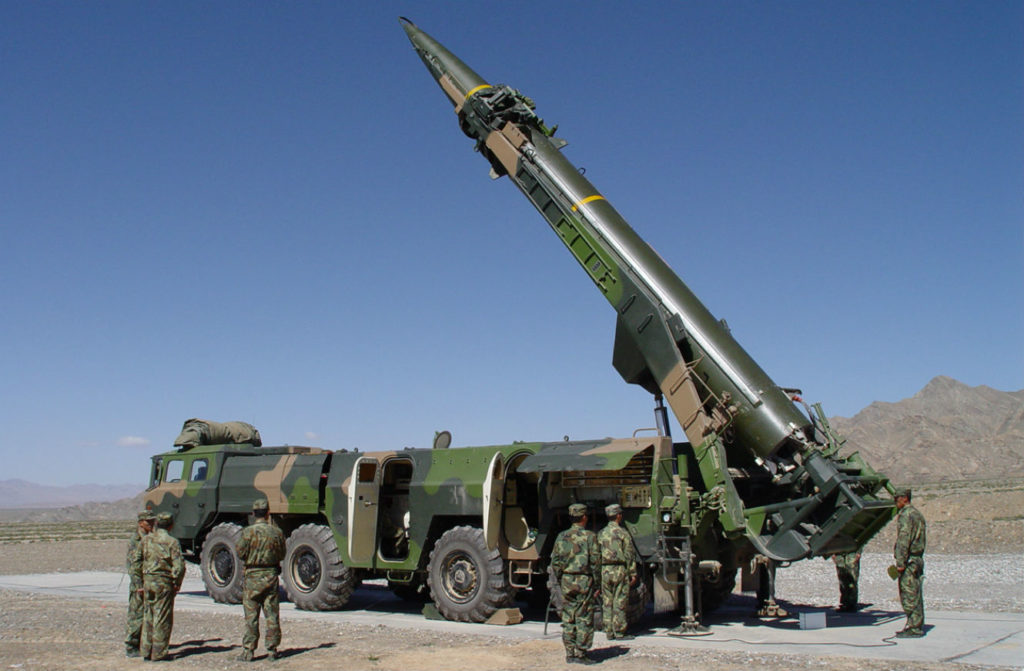
You’ve probably heard that China’s military has developed a “carrier-killer” ballistic missile to threaten one of America’s premier power-projection tools, its unmatched fleet of aircraft carriers. Or perhaps you’ve read about China’s deployment of its own aircraft carrier to the Taiwan Strait and South China Sea. But heavily defended moving targets like aircraft carriers would be a challenge to hit in open ocean, and were China’s own aircraft carrier (or even two or three like it) to venture into open water in anger, the U.S. submarine force would make short work of it. In reality, the greatest military threat to U.S. vital interests in Asia may be one that has received somewhat less attention: the growing capability of China’s missile forces to strike U.S. bases. This is a time of increasing tension, with China’s news organizations openly threatening war. U.S. leaders and policymakers should understand that a preemptive Chinese missile strike against the forward bases that underpin U.S. military power in the Western Pacific is a very real possibility, particularly if China believes its claimed core strategic interests are threatened in the course of a crisis and perceives that its attempts at deterrence have failed. Such a preemptive strike appears consistent with available information about China’s missile force doctrine, and the satellite imagery shown below points to what may be real-world efforts to practice its execution.
The People’s Liberation Army Rocket Force: Precision Strike with Chinese Characteristics
The PLA Rocket Force originally focused on nuclear deterrence. Since the Cold War, the force has increasingly focused on the employment of precision-guided conventional ballistic and land attack cruise missiles. The command now consists of about 100,000 personnel and was elevated in December 2015 to a status co-equal to that of China’s other military services.
In terms of specific missions, Michael S. Chase of the U.S. Naval War College wrote in 2014 that PLA Rocket Force doctrine calls for a range of deterrence, compellence, and coercive operations. In the event that deterrence fails, the missions of a conventional missile strike campaign could include “launching firepower strikes against important targets in the enemy’s campaign and strategic deep areas.” Potential targets of such strikes could include command centers, communications hubs, radar stations, guided missile positions, air force and naval facilities, transport and logistical facilities, fuel depots, electrical power centers, and aircraft carrier strike groups.
Chase also stated that, “In all, Chinese military writings on conventional missile campaigns stress the importance of surprise and suggest a preference for preemptive strikes.” And while most Sinologists discount the idea of a true bolt-from-the-blue attack in a crisis without first giving an adversary a chance to back down, preemptive missile strikes to initiate active hostilities could be consistent with China’s claimed overall military strategy of “active defense.” As a 2007 RAND study of China’s anti-access strategies explained, “This paradox is explained by defining the enemy’s first strike as ‘any military activities conducted by the enemy aimed at breaking up China territorially and violating its sovereignty’…and thereby rendered the equivalent of a ‘strategic first shot.’” China analyst Dean Cheng stated similarly in 2015, “From Mao to now, the concept of the active defense has emphasized assuming the strategic defensive, while securing the operational and tactical initiative, including preemptive actions at those levels if necessary.” Thus, China could consider a preemptive missile strike as a defensive “counter-attack” to a threat against China’s sovereignty (e.g., over Taiwan or the South China Sea) solely in the political or strategic realm.
If such a strike still seems unlikely, consider that U.S. military and civilian leaders may have a blind spot regarding the capabilities of the PLA Rocket Force. The bulk of the PLA Rocket Force — the conventionally armed precision-strike units — have no real counterpart in the U.S. military. American long-range ballistic missiles are all nuclear-tipped and therefore focused on nuclear deterrence, and the Army’s short-range tactical ballistic missiles are designed for battlefield use. Also, per the Intermediate Nuclear Forces Treaty with Russia, the United States fields no medium- or intermediate-range ballistic missiles of any kind, nor any ground-launched land-attack cruise missiles (LACMs). When Americans think of preemptive strike, they likely think of weapons launched by air or sea-based platforms, discounting the viability of a different paradigm: ground-based precision-strike missiles used for the same mission.
Coming of Age
A 2015 RAND study said that by 2017 (i.e., now) China could field about 1,200 conventionally armed short-range ballistic missiles (600-800 km range), 108 to 274 medium-range ballistic missiles (1000 to 1500+ km), an unknown number of conventional intermediate-range ballistic missiles (5,000 km), and 450-1,250 land attack cruise missiles (1500+ km). RAND also estimated that improvements in the accuracy of China’s ballistic missiles may allow them to strike fixed targets in a matter of minutes with an accuracy of a few meters. RAND assesses that key U.S. facilities throughout Japan could already be within range of thousands of difficult-to-defeat advanced ballistic and cruise missiles. Even U.S. bases on the island of Guam could be within range of a smaller number of missiles (See Figure 1).
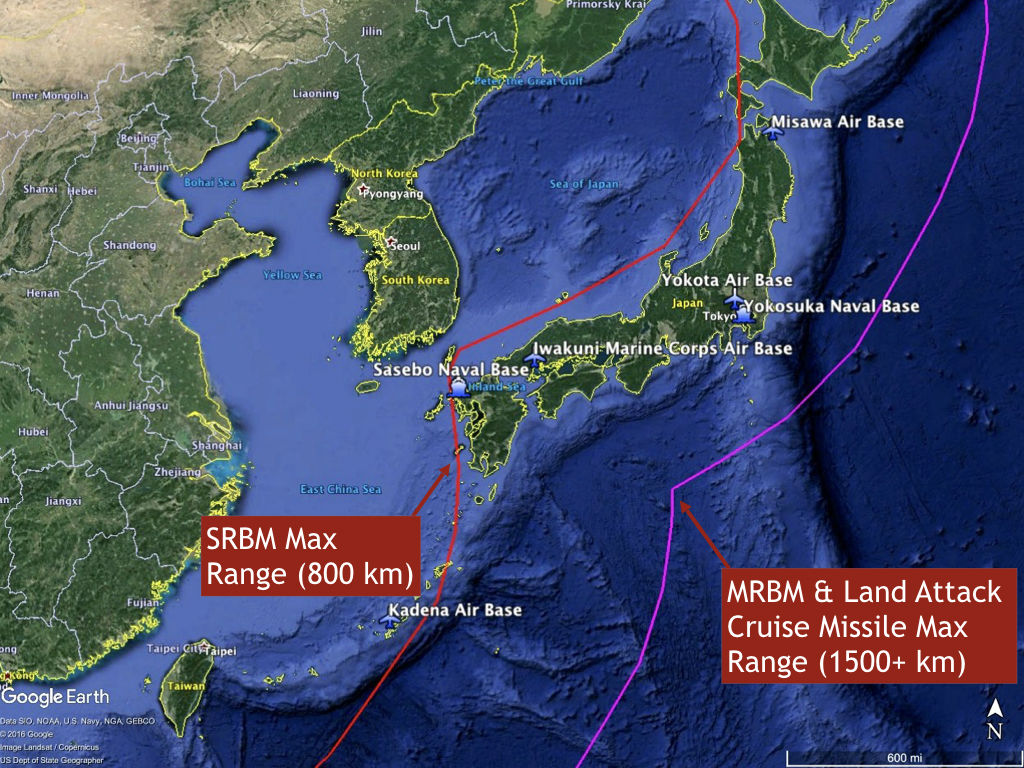
In recent years, the PLA Rocket Force appears to have been making real the specific capabilities necessary to support execution of the preemptive strike discussed above. As examples, a 2009 RAND study of open-source literature suggested that flechette sub-munitions would likely be used against missile launchers, parked aircraft, fuel tanks, vehicles, air defense weapons, and ships in port. Penetrating munitions would be used against airfield runways, aircraft shelters, and semi-underground fuel tanks. In terms of sequencing, the study suggested that an initial wave of ballistic missiles would neutralize air defenses and command centers and crater the runways of military air bases, trapping aircraft on the ground. These initial paralyzing ballistic missile salvos could then be followed by waves of cruise missiles and Chinese aircraft targeting hardened aircraft shelters, aircraft parked in the open, and fuel handling and maintenance facilities.
These capabilities may already have been tested at a ballistic missile impact test site (see Figure 2) located on the edge of the Gobi Desert in western China. Commercial satellite images seem to show a range of test targets representing just the sort of objectives discussed in the doctrine above, including groups of vehicles (perhaps representing mobile air and missile defense batteries — see Figure 3), aircraft targets parked in the open (Figure 4), fuel depots (Figure 5), runway cratering submunition tests (Figure 6), electrical power facilities (Figure 7), and the delivery of penetrating munitions to hardened shelters and bunkers (Figure 8). Of note, the 2007 RAND study mentioned above stated that submunitions are generally not capable of penetrating the hardened shelters use to house fighter aircraft at many air bases, that China’s ballistic missiles lack the accuracy to ensure a high percentage of direct hits using unitary warheads, and thus, “fighter aircraft in hardened shelters would be relatively safe from Chinese ballistic missile attack.” This clearly appears to no longer be the case, and the demonstrated ability to precisely deliver penetrating warheads to facilities such as command centers in a matter of minutes could also provide a key capability to destroy them, with their command staffs, in the initial waves of an attack.
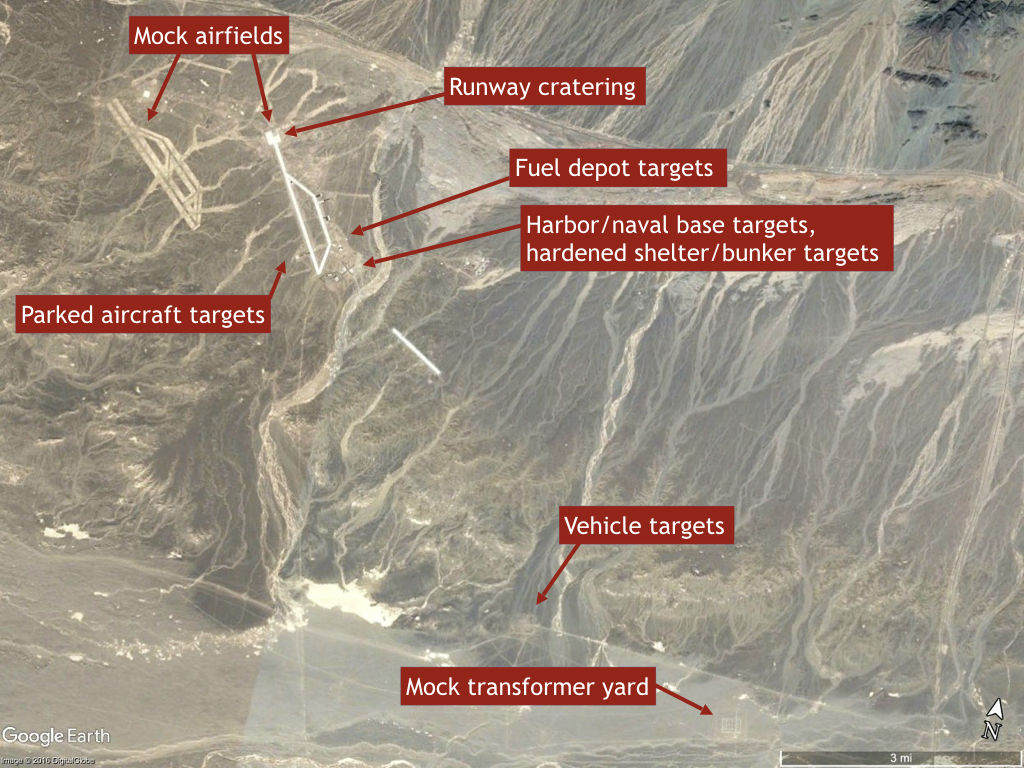
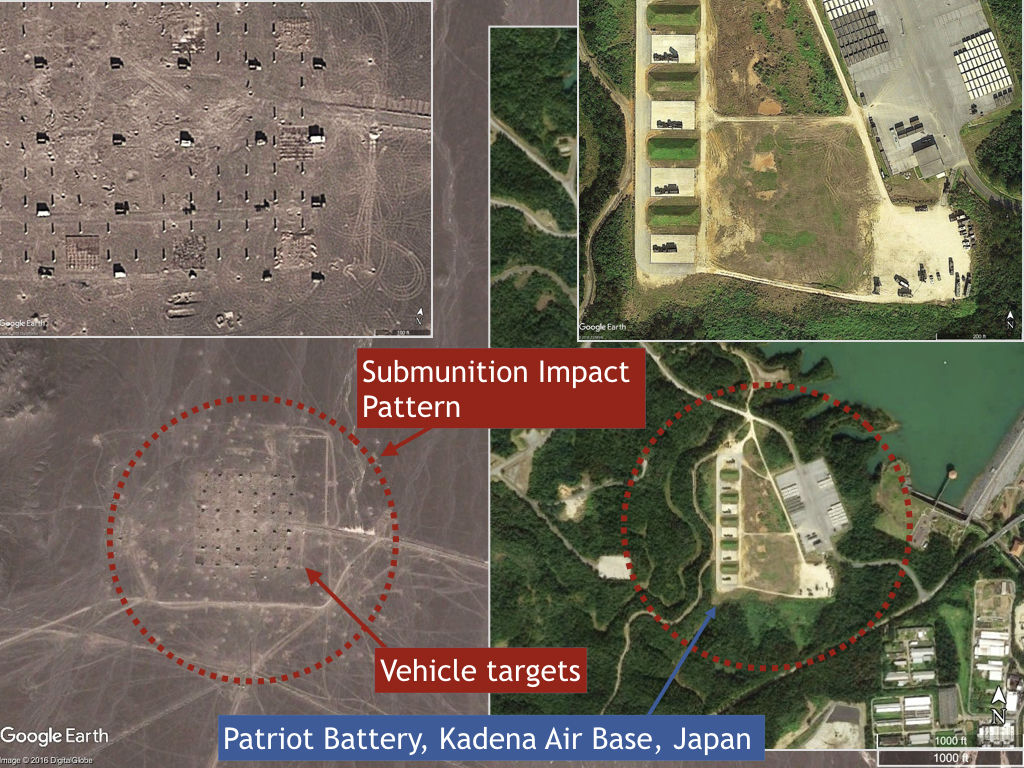
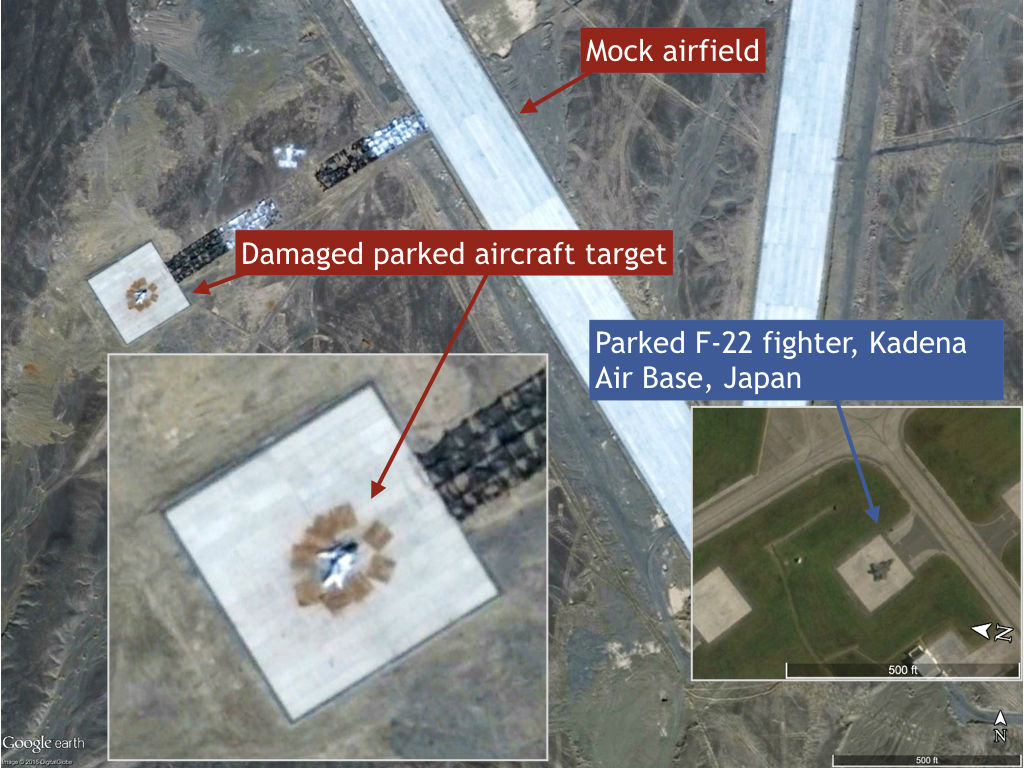
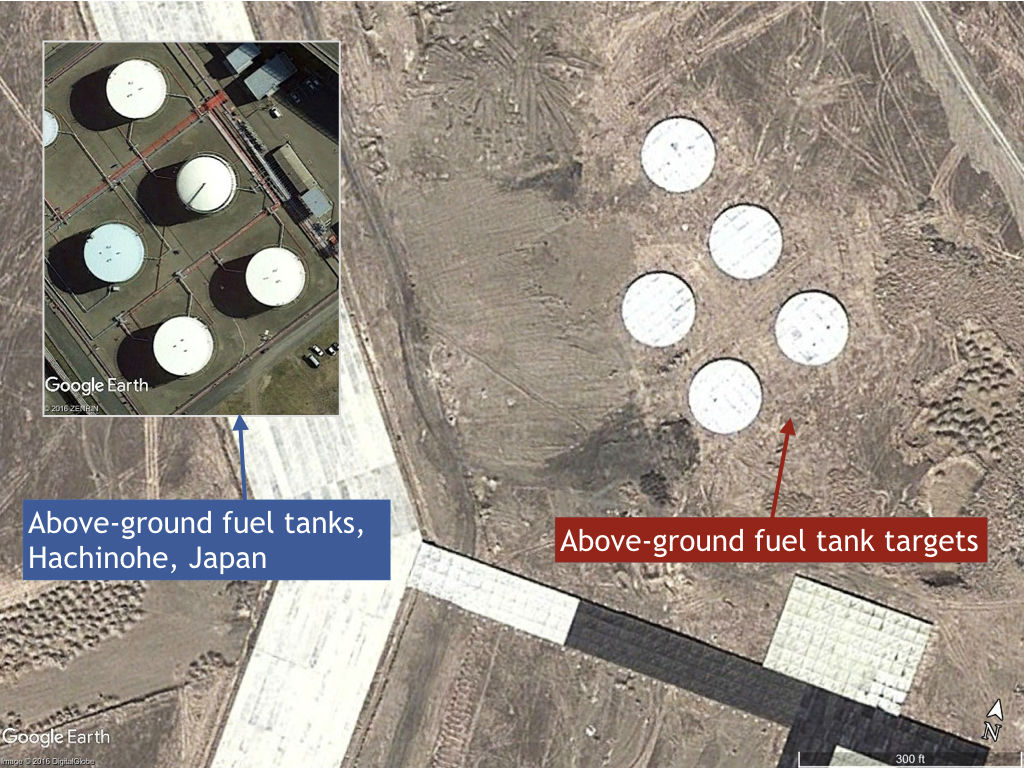
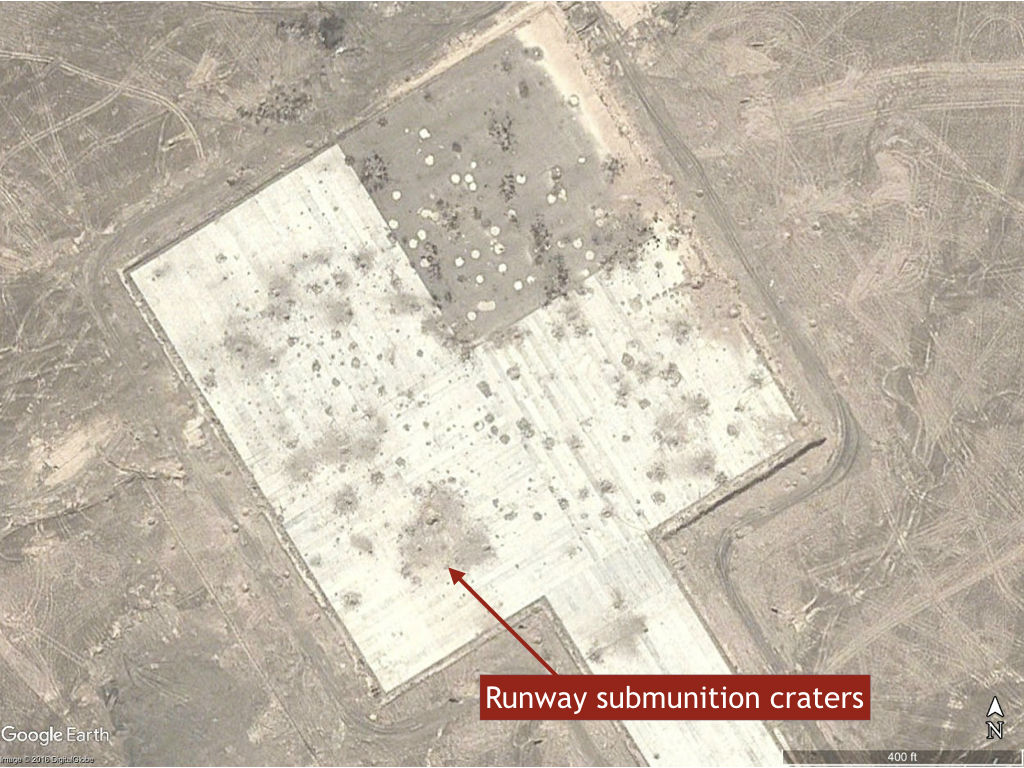
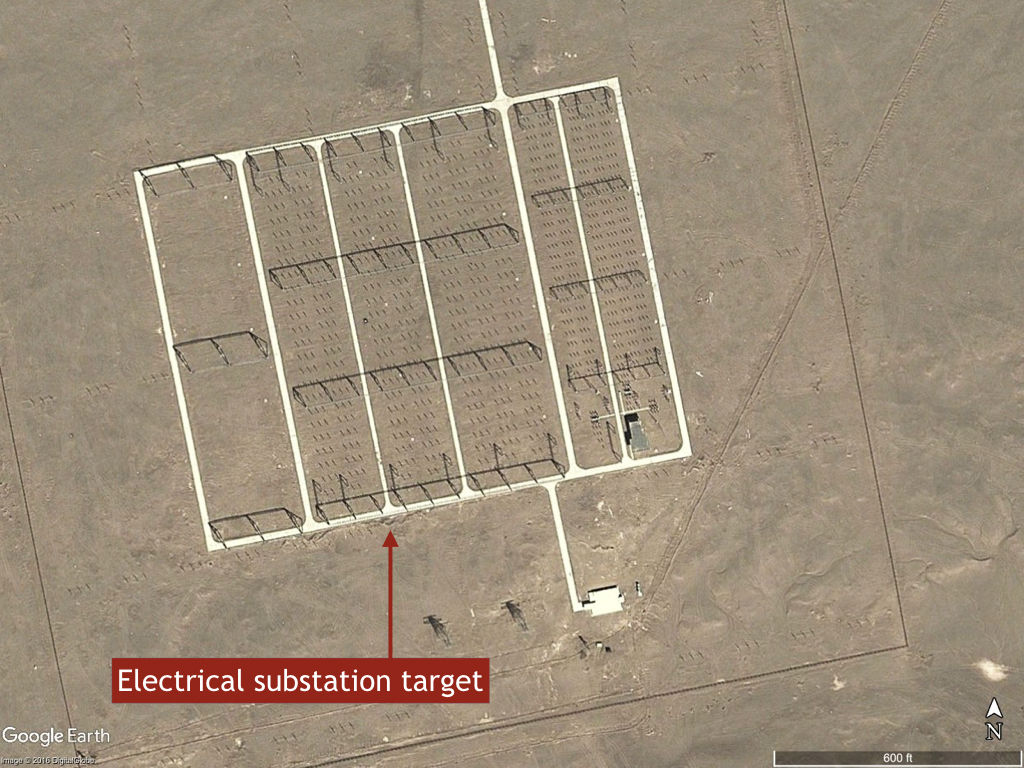
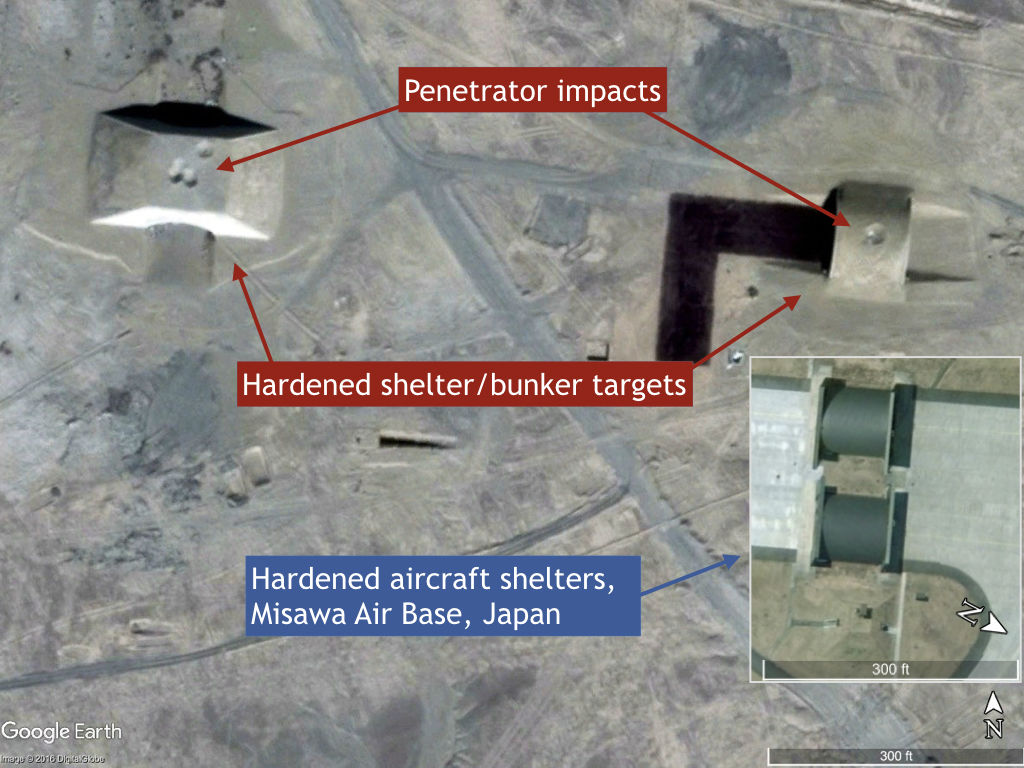
China has not been shy about displaying the advancing capabilities of the PLA Rocket Force. Beijing openly displayed some of its latest missiles (such as DF-26 “Guam-killer” missile) in its 70th anniversary parade in 2015 and painted the missiles’ identification on their sides in western characters, in case anyone missed the point. The PLA Rocket Force also put out a recruiting music video and other TV footage showing the employment of multiple coordinated missile launches, as well as the use of submunitions.
Pearl Harbor 2.0?
In 2010, Toshi Yoshihara of the U.S. Naval War College wrote that authoritative PLA publications indicated that China’s missile forces might attempt a preemptive strike to knock out the U.S. Navy in Asia by specifically targeting vulnerable carriers and warships in port. Yoshihara noted in particular that, “Perhaps no other place captures the Chinese imagination as much as Yokosuka,” the major U.S. naval base near Tokyo home to the U.S. Navy’s sole permanently forward-deployed aircraft carrier, USS Ronald Reagan (CVN 76), as well as other ships and vital support facilities (see Figure 9). In 2012, Dr. Yoshihara again stated that:
[T]he Imperial Japanese Navy’s surprise attack on Pearl Harbor remains a popular, if somewhat tired, metaphor for the dangers of unpreparedness and overexposure to risk…But the real possibility that U.S. bases in the Western Pacific could once again be vulnerable…has occasioned little publicity or debate.
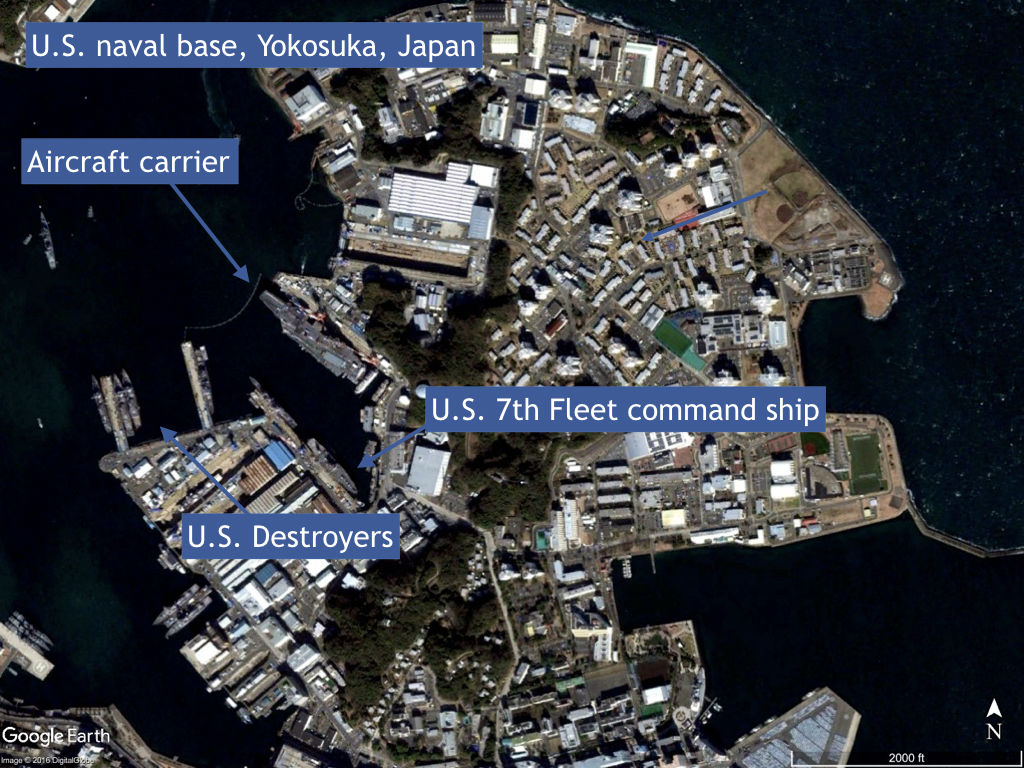
Evidence that China may have been practicing to strike ships in port with ballistic missiles would lend credence to Yoshihara’s concerns. And such evidence exists: images taken in 2013 (see Figure 10) seem to show China testing its ability to do so.
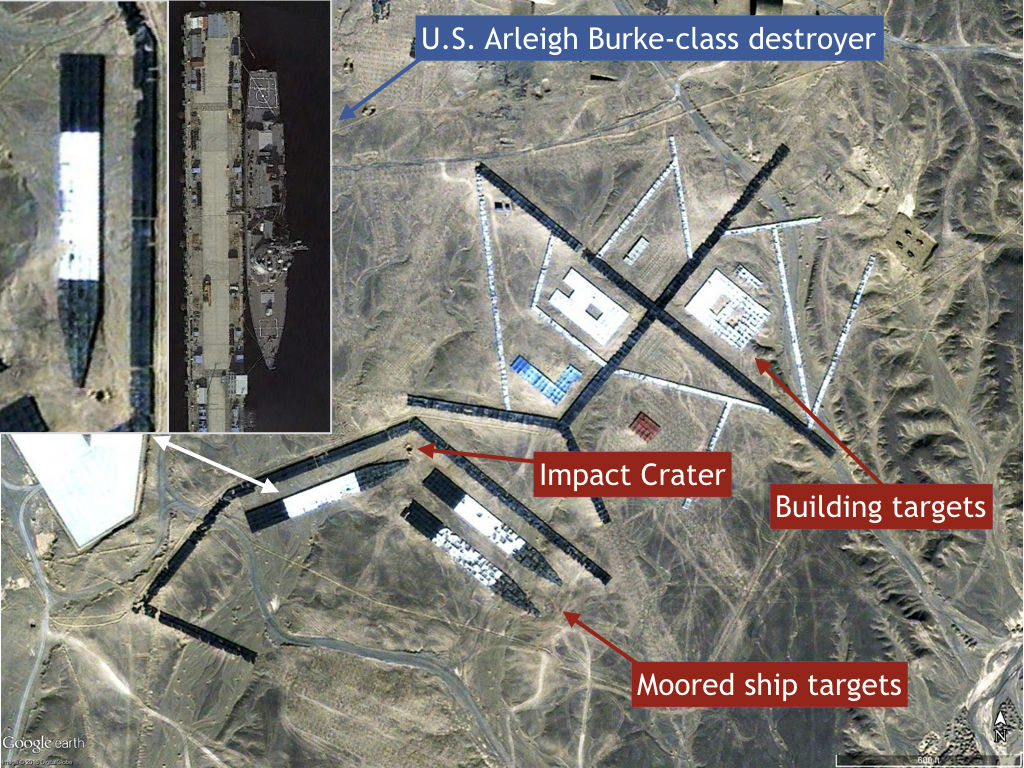
Specifically, the PLA Rocket Force appears to have been practicing on several ship targets of a similar size to U.S. Arleigh Burke-class destroyers moored in a mock port that is a near-mirror image of the actual inner harbor at the U.S. naval base in Yokosuka (see Figure 11). Note what looks like an impact crater located near the center of the three ship targets, close enough to have potentially damaged all three ships with submunitions. The display of these targets may itself constitute signaling to the United States and its allies as a long-term deterrent effort. All the same, it bears considering that the only way that China could realistically expect to catch multiple U.S. ships in port as shown above would be through a surprise attack. Otherwise, with clear signs of imminent hostilities, the United States would likely have already sent its fleet to sea. Some skeptics might say that catching the U.S. flat-footed would be unlikely, but history teaches us not to discount the possibility of successful surprise attacks.
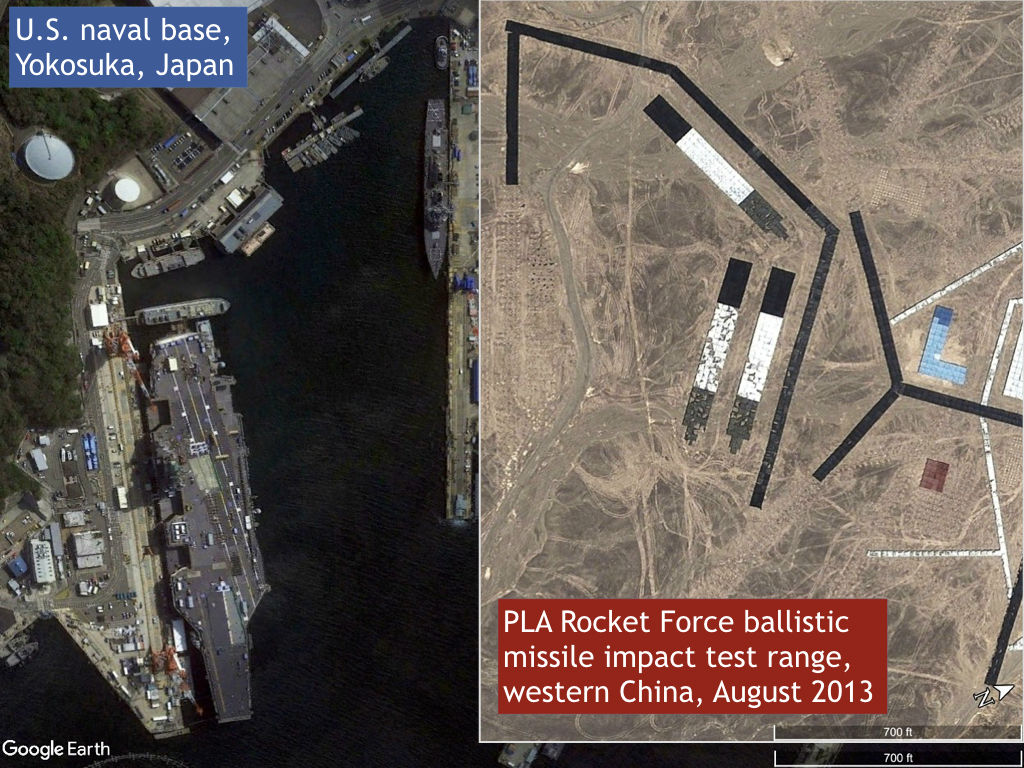
The Need for Enhanced Deterrent Measures
U.S. and allied efforts are underway to improve defensive areas such as base hardening and force dispersal, as well as to conduct advanced research into ballistic missile defenses such as high-velocity projectiles, rail guns, and lasers. My colleague Elbridge Colby has written with Jonathan Solomon extensively about conventional deterrence and the specific capabilities that the United States can develop in the next few years that will be critical to fielding a force “that can prevail in regional wars while still performing peacetime missions at a reasonable level.” The possibility that a threat of preemptive attack from the PLA Rocket Force already exists underscores an urgent need to take further action now.
First, the United States should very publicly deploy the most robust missile defenses that it can to protect its bases in Japan. In the long term, technological breakthroughs will probably be necessary to pace the growing precision-strike ballistic missile threat at a reasonable cost. But for now, a layered ballistic missile defense is necessary, as the short-range Patriot air and missile defense batteries currently guarding U.S. and allied bases in Japan seem unlikely to succeed against a mass Chinese raid. Such a robust missile defense also requires deployment of the U.S. Army’s Terminal High Altitude Air Defense (THAAD) system to Japan and/or tasking Aegis ballistic missile defense destroyers for duty focused on the defense of U.S. bases. Given that U.S. destroyers would likely have other business to conduct in a conflict with China, near-term deployment of THAAD to Japan (which will require tough trade-offs given the current worldwide demand and limited number of available batteries) is necessary to defend U.S. forces. Once deployed, U.S. and allied ballistic missile defense forces will need to publicly practice coordinated defense against mass ballistic missile attacks. Even well-practiced defenders would face a tough challenge in coordinating a real-world defense against a ballistic missile attack of unprecedented scale from a potentially flat-footed stance, with mere minutes to do so and only one chance to get it right.
Given the difficulty and uncertainty associated with defending against a mass missile raid even with robust, layered defenses, U.S. forces and personnel stationed at bases in Japan and Guam need to practice rapid evacuation of the types of facilities targeted in Rocket Force doctrine. Similarly, key U.S. command centers in Japan should practice rapid execution of continuity of operations plans, given that the time available between the first detection of a missile launch by U.S. space-based missile warning sensors to its impact would probably be on the order of 10 to 15 minutes. In that short amount of time, U.S. early warning centers would have to detect the launched strike, assess it, and warn U.S. forces overseas. Those overseas personnel and command staffs would then need to execute evacuation and continuity procedures in a matter of a few short minutes. Similarly, U.S. ships in port in the Western Pacific would need to be able get away from their pier positions in a matter of minutes, and high-value air units in the region would need to be able to quickly move their aircraft from their parked positions. In any case, no margin of error will exist for lack of training or proficiency in execution.
The United States and its allies should take action now to ensure that China does not think that it can gain the upper hand in a conflict through successful missile strikes against U.S. bases in Asia. They must ensure that China is not tempted, as some of the United States’ previous adversaries have been, into making the grave error of trying to knock the United States down, expecting it not to get back up.
Thomas Shugart is a Senior Military Fellow at the Center for a New American Security and a submarine warfare officer in the U.S. Navy. The opinions expressed here are the author’s and do not represent the official position of the U.S. Navy, Department of Defense, or the U.S. government.

